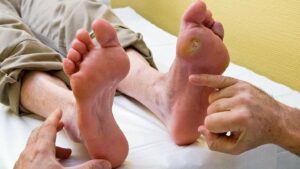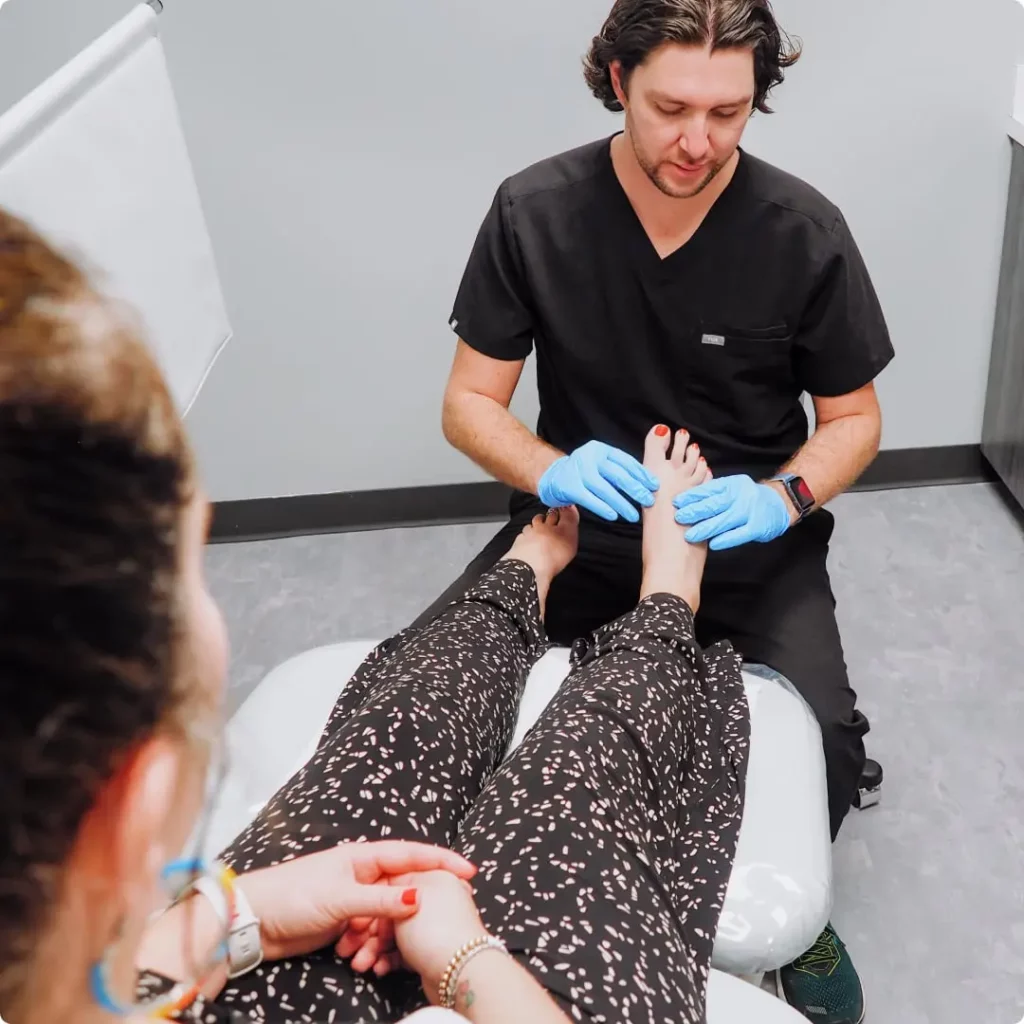Diabetic foot ulcers are a common and serious complication of diabetes, posing a significant risk for those living with this chronic condition. These ulcers are the result of skin tissue breaking down and exposing the layers underneath. Individuals with diabetes must be aware of the early signs and symptoms of foot ulcers to prevent complications, including infections and, in severe cases, amputation. In this blog, we will explore the key symptoms of diabetic foot ulcers, their causes, and effective strategies for prevention and management.
Contents
How Does a Diabetic Foot Ulcer Start?
 Diabetic foot ulcers typically start due to a combination of factors associated with diabetes. Here’s a more detailed look at how they develop:
Diabetic foot ulcers typically start due to a combination of factors associated with diabetes. Here’s a more detailed look at how they develop:
- Neuropathy (Nerve Damage): Diabetes can cause neuropathy, which leads to reduced sensation in the feet. This numbness means that minor cuts, blisters, or sores on the feet may not be noticed immediately.
- Minor Foot Injury: Because of the reduced sensation, a diabetic person might not feel a small injury, like a blister from tight shoes, a small cut, or a scrape.
- Poor Circulation: Diabetes also affects blood circulation, making it harder for blood – carrying oxygen and nutrients – to reach the feet. This impaired blood flow slows down the healing process of any wound or injury.
- High Blood Sugar Levels: Elevated glucose levels can impair the body’s natural healing process and weaken the immune system. This makes it harder for the body to heal the wound and fight off any potential infection.
- Wound Development: Without timely detection and proper care, a small injury can quickly escalate into a wound. Continued pressure or irritation on the affected area can further aggravate the injury, leading to the development of an ulcer.
- Infection Risk: If the ulcer is not treated properly, there’s a risk of infection. Due to the poor circulation and reduced ability to fight infection, these ulcers can deteriorate rapidly.
Individuals with diabetes need to practice good foot care, including regular inspection of their feet, proper hygiene, and wearing appropriate footwear. Additionally, controlling blood sugar levels is crucial in preventing the development of foot ulcers and other complications associated with diabetes.
What Are The Symptoms Of Diabetic Foot Ulcers?
 The symptoms of diabetic foot ulcers can vary depending on the severity and stage of the ulcer, but generally include the following:
The symptoms of diabetic foot ulcers can vary depending on the severity and stage of the ulcer, but generally include the following:
Pain and Sensitivity
One of the first signs of a diabetic foot ulcer is often a noticeable change in sensitivity or pain in the foot. This can manifest as a dull ache, sharp pain, or a burning sensation. It’s important to note that due to diabetic neuropathy, which causes numbness or reduced sensation in the feet, pain might not always be present. This lack of sensation can be dangerous, as it might lead to delays in noticing and treating injuries or ulcers.
Skin Changes
The skin around a forming ulcer may exhibit various changes. This includes redness, swelling, or warmth to the touch. The skin might also become dry and flaky or conversely, overly moist. These changes are indicative of inflammation and possible infection. Additionally, a noticeable discoloration, particularly a darkened area, might suggest tissue death around the ulcer. Such changes in the skin are warning signs and should prompt immediate medical attention.
Drainage from the Foot
Drainage or discharge from an ulcer is a common symptom. This might be observed as staining or wetness on the socks or footwear. The drainage can vary in color from clear to yellowish, or even bloody. It’s an indication that an open wound is present and possibly infected. The drainage is often accompanied by a foul odor. This is a clear sign of infection that requires urgent medical intervention.
Slow Healing of Wounds
In people with diabetes, wounds, cuts, or blisters on the feet tend to heal much slower than usual. This slow healing is due to a combination of poor circulation and high blood sugar levels, which impair the body’s natural healing process. A minor injury, which might heal quickly in a non-diabetic individual, can linger and worsen, potentially developing into an ulcer. Any wound on the foot that does not show signs of healing within a reasonable timeframe should be evaluated by a healthcare professional, as it could be the beginning of an ulcer.
Change in Foot Appearance
A diabetic foot ulcer can lead to changes in the overall appearance of the foot. This might include swelling of the foot or ankle, and in severe cases, deformation of the foot structure. Such deformities can arise from the breakdown of tissues or joints due to the ulcer or underlying infection. These changes can affect the individual’s gait and lead to further complications, such as the development of additional ulcers due to uneven weight distribution on the feet.
Foul Smell
The presence of a foul smell emanating from a diabetic foot ulcer is a strong indicator of infection. This odor is typically caused by the presence of bacteria or other pathogens in the wound. As the bacteria multiply and break down tissue, they release unpleasant-smelling compounds. This symptom is particularly concerning because it suggests that the ulcer is not only open and vulnerable but also possibly colonized by bacteria that are actively causing tissue damage.
Black Tissue (Eschar)
The appearance of black tissue around a diabetic foot ulcer, known as eschar, is a sign of necrosis, or tissue death. Eschar forms when blood flow to the tissue is severely reduced or completely cut off, leading to the death of the tissue. This blackened, sometimes hard or leathery tissue, is a serious concern because it indicates an advanced stage of the ulcer, and often underlies deeper tissue or bone infection. Eschar formation requires immediate medical evaluation, as it significantly increases the risk of serious complications.
Numbness or Tingling
Numbness or tingling in the foot, especially around the area of an ulcer, is often a result of diabetic neuropathy. This condition is caused by prolonged high blood sugar levels damaging the nerves, particularly in the extremities like the feet. The damaged nerves can produce sensations of tingling, burning, or even complete numbness. This reduced sensation is a double-edged sword; it can mask the pain of a developing ulcer, leading to delayed treatment, but it can also be a sign that an ulcer is present or worsening.
Individuals with diabetes must inspect their feet daily for any signs of ulcers and seek immediate medical attention if they notice any of these symptoms. Early detection and treatment are key to preventing complications.
How To Take Care Of Diabetic Foot Ulcers?
 Taking care of diabetic foot ulcers involves a multifaceted approach that includes both medical treatment and self-care practices. Here are key strategies for managing and treating diabetic foot ulcers:
Taking care of diabetic foot ulcers involves a multifaceted approach that includes both medical treatment and self-care practices. Here are key strategies for managing and treating diabetic foot ulcers:
- Proper Wound Care
Keeping the ulcer clean and properly dressed is vital. This typically involves cleaning the wound, applying appropriate wound dressings, and changing them regularly as instructed by a healthcare professional. The type of dressing depends on the ulcer’s stage and condition.
- Off-loading
Reducing pressure and friction on the ulcerated area is critical for healing. This might involve using special footwear, foot braces, orthotic devices, or a wheelchair or crutches to offload weight from the foot.
- Control Blood Sugar Levels
Effective management of diabetes is essential for healing foot ulcers. High blood sugar levels can impair the body’s ability to heal and increase the risk of infection. This includes following a diabetes-friendly diet, regular exercise, and taking diabetes medications as prescribed.
- Good Hygiene
Keeping the feet clean and dry helps prevent infection. Wash feet daily with mild soap and warm water, drying them thoroughly, especially between the toes.
- Avoid Walking Barefoot
To prevent injury, always wear shoes or slippers, even indoors. Avoiding barefoot walking helps protect the feet from cuts, scrapes, and other injuries that could lead to ulcers.
- Regular Foot Inspections
Daily self-inspections of the feet can help catch ulcers or other foot problems early. Look for cuts, blisters, redness, swelling, or any unusual changes. Use a mirror to check the bottoms of your feet or ask someone for help if you have trouble seeing them.
- Stop Smoking
Smoking impairs circulation and can significantly slow down the healing process. Quitting smoking is a key step in managing diabetic foot ulcers effectively.
- Nutritional Support
A diet rich in vitamins and minerals, especially those that promote skin health and wound healing (like Vitamin C, Zinc, and Protein), can aid in the healing process.
- Education and Awareness
Educating oneself about diabetes and foot care is crucial. Understanding the risks and prevention strategies can significantly reduce the chances of developing foot ulcers.
Overall, managing diabetic foot ulcers effectively requires a combination of good diabetes management, proper foot care, and adherence to medical advice. Early detection and treatment are key to preventing complications and promoting healing.
Conclusion
In conclusion, knowing the symptoms of diabetic foot ulcers is important for care that requires a comprehensive approach. Regular medical check-ups, meticulous wound care, maintaining optimal blood sugar levels, and practicing good foot hygiene are essential steps in managing these ulcers. Hence, it’s also important to be proactive in preventing ulcers by wearing appropriate footwear, conducting daily foot inspections, and avoiding smoking.
By taking these steps, individuals with diabetes can significantly reduce the risk of complications associated with foot ulcers. So, staying informed and vigilant about foot health is paramount for anyone managing diabetes. Do you want to get rid of diabetes? Join our online diabetes treatment program and reverse Diabetes naturally through lifestyle changes such as a Personalized Diet plan, Exercise, Yoga, dieticians, and health coaches.

